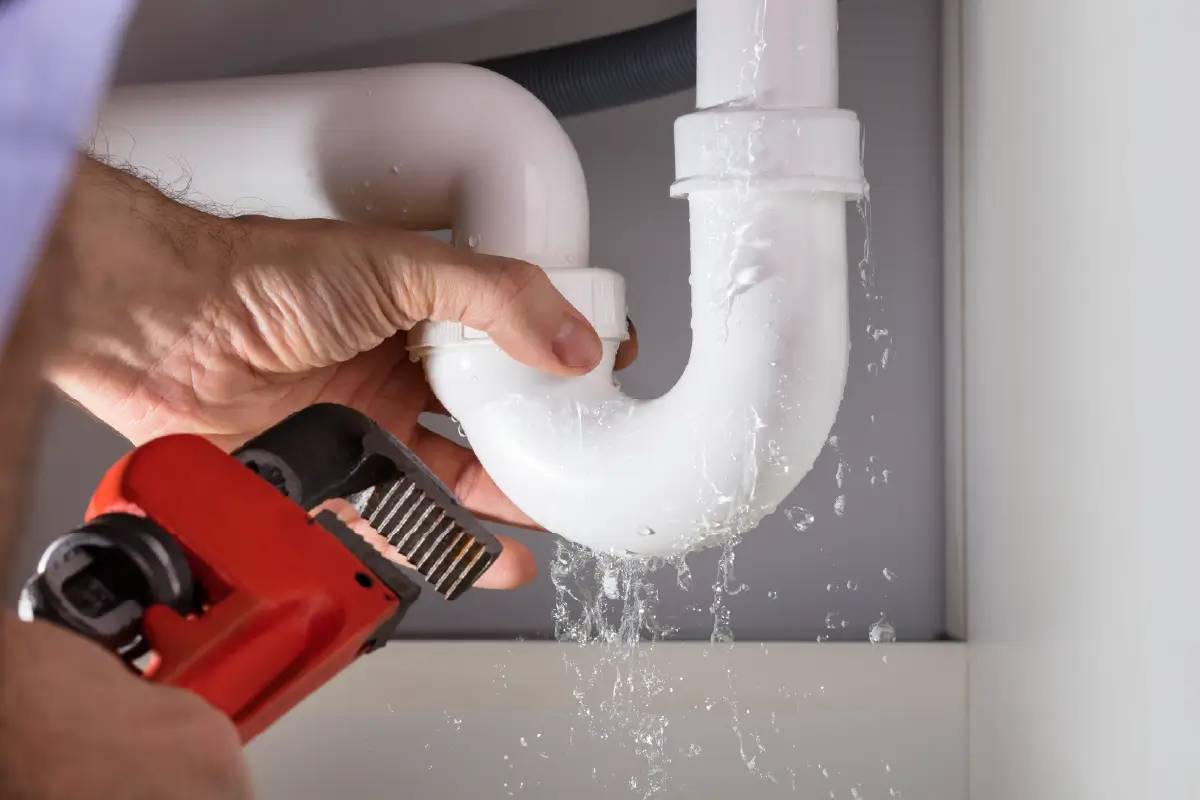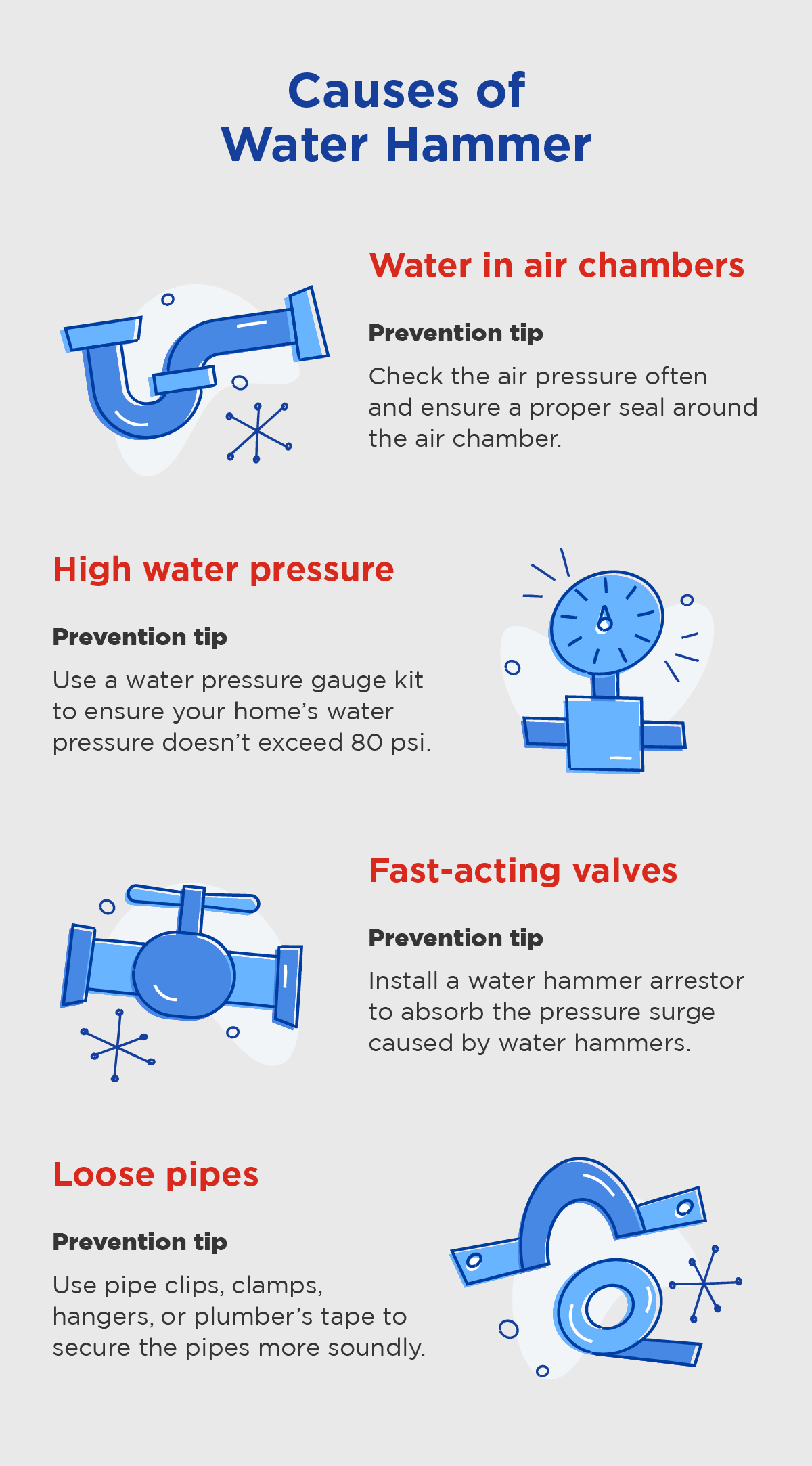
Mr. Rooter Plumbing explains how to address a water hammer, a common plumbing issue.
|
Water hammer occurs in a plumbing system when there’s a sudden change in water flow. Also referred to as hydraulic shock, water hammer is caused by an increase in pressure when a faucet, valve, or water appliance is shut off. The water looks for a place to go as it quickly changes direction, and it ultimately bangs against the pipe walls or the shut-off valve in your water system, making a distinct (and alarming) pounding noise.
Aside from gentle whooshing, water pipes should be fairly quiet. So it’s perplexing when you suddenly hear banging coming from your pipes. It’s important to address water hammer promptly, as it can cause excessive wear on pipes and even lead to leaking pipes. Keep reading to learn more about what causes water hammer and how to prevent it from happening in your home.
What Causes Water Hammer?
Any change in water flow can cause a water hammer to form in your plumbing system. Here are a few common causes of water hammer to keep in mind.
Water in air chambers
The most common cause of a water hammer is too much water in an air chamber. Air chambers are vertical pipes that regulate pressure and prevent water from forming waves in the supply pipes and causing water hammers. Sometimes, if there are loose connections or faulty seals, air can leak out, causing a pressure difference that draws water into the chamber. If water fills the chamber, there’s no available air to absorb the pressure, which could cause a water hammer.
High water pressure
High water pressure is another common cause of a water hammer. If your plumbing system’s sitting pressure is above the recommended range (45-55 psi), you may hear water hammer noises quite frequently. High water pressure increases the force of the moving water, making it more susceptible to water hammer when there’s a sudden stop in water flow.

Fast-acting valves on appliances
Sometimes a single appliance is responsible for pressure fluctuations that cause a water hammer. Washing machines, dishwashers, ice makers, or sprinkler systems, for example, often have fast-acting valves called solenoid valves that close very quickly, causing water hammer. If the loud banging noise caused by the water hammer occurs only when that appliance runs or turns off, you’ve found the culprit.
Loose pipes or worn valves
Old water supply pipes are often not secured sufficiently to a home’s structural features, so they swing and wiggle when there’s a pressure change. This can also happen to water valves with worn-out washers or loose packing, which can magnify the vibrations caused by the water hammer.
What Are the Effects of Water Hammer?
Aside from noisy pipes, water hammers can lead to significant problems if left unaddressed, including:
- Leaks: Weak joints, fittings, or connections on a pipe can occur from the pressure caused by water hammers, leading to leaks that can cause water damage in the home.
- Burst pipes: In some cases, unaddressed water hammers, especially in older plumbing systems, can cause pipes to burst or crack, often requiring extensive repairs.
- Flawed appliances: Pressure fluctuations caused by water hammers can cause stress to the internal components of appliances that use water, which can cause technical difficulties or system failures.
- Property damage: In extreme cases, undetected leaks caused by water hammers can lead to structural issues and exterior damage in a home. Leaks can also come in contact with electrical wiring, posing serious safety concerns.
- Financial burden: Water hammers can also cause significant financial hardship due to the repairs and replacements needed for extensive damage.
How To Prevent Water Hammer
To prevent water hammer from damaging your plumbing system, consider implementing the following methods.
Install water hammer arrestors
A water hammer arrestor, also called an in-line water surge arrestor, can be found at most hardware stores. These devices are small chambers installed near appliances or at the ends of pipes to absorb the pressure surge.
You can choose an arrestor type based on the appliance and space available. For example, a washing machine may need a larger hose-bib-style pressure arrestor on the water intake line, as a high volume of water will be flowing through.
If there’s little room to install one of these, you can find a mini end-stop water hammer arrestor, which is a 90-degree connector that threads right onto the hose connection of most appliances and fits in tighter spaces.
The third type of arrestor is a single-chamber arrestor, which you can install on any standard-width section of pipe, wherever needed. Hopefully, an arrestor for that troublemaker appliance will resolve your pipe-pounding headache!
Secure loose pipes
Grab a flashlight and check your crawl space or basement’s visible supply pipes. Try to move different sections gently and see if they budge significantly in any areas. It can also be helpful to have another person run some water and turn it off to cause the water hammer; from your position, you might be able to locate the spot causing the hammer.
Pipe supports — also called pipe clips, clamps, and hangers — or plumber’s tape can help secure the pipes more soundly. If you have copper pipes, avoid using galvanized or steel supports or straps, as the metals could react poorly together (electrolysis) and cause a leak. Plastic clips and plumber’s tape are the safest options and are fairly easy to use.
Install or reset air chambers
If you don’t have air chambers, which is unlikely unless you have an old plumbing system, have a professional install them at key points in your system to eliminate the waves that cause water hammers.
To reset your air chambers, turn off your main water shut-off valve, then open all your faucets and valves. Don’t forget to open the lowest faucet you have, which could be on an outdoor hose bib or a basement sink.
Opening the faucets will drain any water suspended by pressure and allow the air chambers to clear. Turn all the faucets off, then turn your water back on, and the water hammer should resolve. If not, there may be another issue.
Address high water pressure
Checking your home’s water pressure is fairly easy with a residential water pressure gauge kit from a hardware store.
To check your water pressure, turn off all appliances and faucets that use water — don’t forget sprinkler systems and refrigerators with ice makers. Then screw the pressure gauge onto a valve or hose bib that’s close to your main water supply source (either a municipal water meter or a well pressure tank).
Open that valve slowly until it’s fully open. When the needle on the gauge stops moving, read your residential pressure. Test one more time to be sure the reading is accurate. If the pressure exceeds 80 psi, contact a plumber to install a pressure regulator or replace an existing one on the water main.
Get Help Fixing Water Hammer With Mr. Rooter Plumbing
If you’re experiencing frequent or severe problems caused by water hammer, it’s always best to contact a qualified plumber to diagnose the problem and recommend the best solution. At Mr. Rooter Plumbing®, our skilled service professionals are always ready to help.
Schedule an appointment online or give us a call to see how we can help you fix and prevent water hammer.

